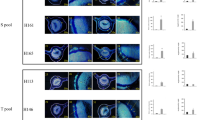Abstract
SINCE the production of new morphological types in the course of grafting experiments of tomato on Solanum nigrum in 1910 by Winkler1 and the description of the difference between the white-edged and solid-green leaf varieties of Pelargonium zonale by Baur2, the spontaneous occurrence of chimæras, particularly in fruits and flowers, has been reported in many crops and ornamental plants. More recently, Sativa and Blakeslee3 have reported the induction of chimæras by treatment of germinating seed with colchicine. The occurrence of a chimæra in tea of the type described, however, has not been previously reported. Gadd4, in a discussion of non-infectious chlorosis in tea, says: “The yellow colour is due to lack of chlorophyll, though why it should not develop normally in particular zones is not known”.
This is a preview of subscription content, access via your institution
Access options
Subscribe to this journal
Receive 51 print issues and online access
$199.00 per year
only $3.90 per issue
Buy this article
- Purchase on Springer Link
- Instant access to full article PDF
Prices may be subject to local taxes which are calculated during checkout
Similar content being viewed by others
References
Winkler, H., Z. Bot., 2, 1 (1910).
Baur, E., Einführung indie experimentelle Verebungslehre (1922).
Sativa, S., and Blakeslee, A. F., Amer. J. Bot., 28, 862 (1941).
Gadd, C. H., Mono. Tea Production in Ceylon, No. 2 (Tea Research Institute of Ceylon, 1949).
Author information
Authors and Affiliations
Rights and permissions
About this article
Cite this article
SAMARAWIRA, I. A Periclinal Chimæra in Tea. Nature 199, 824–825 (1963). https://doi.org/10.1038/199824a0
Issue Date:
DOI: https://doi.org/10.1038/199824a0
This article is cited by
Comments
By submitting a comment you agree to abide by our Terms and Community Guidelines. If you find something abusive or that does not comply with our terms or guidelines please flag it as inappropriate.



